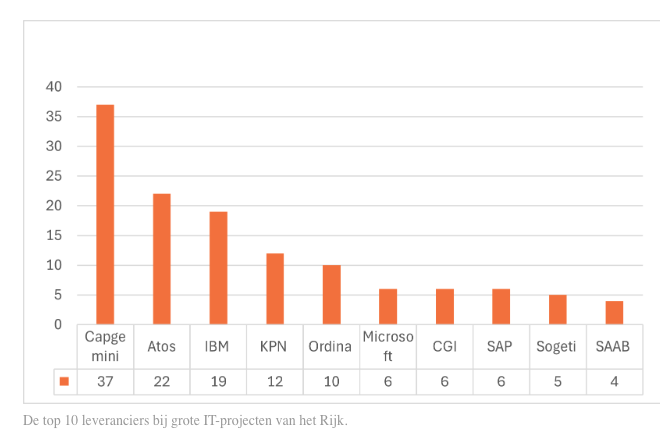5 proposals for a future-proof government

The state is responsible for society’s most critical infrastructure: childcare, healthcare, and taxation. When government IT systems fail, the harm is not abstract. People lose benefits, face unjust debts, and spend years navigating opaque bureaucracy. The Dutch childcare benefits scandal made this painfully clear — with digitization cited 92 times as a core factor for institutional failure. The parliamentary inquiry was blunt: unless fundamental changes are made, similar failures will happen again. Improving the state’s digital capacity is not about new apps or branding. It is about fixing the structural dysfunction in how policy, operations, and technology interact. Below are five proposals to do just that — drawn from interviews with officials, practitioners, and institutions in the Netherlands and abroad.
1. Create a Minister for Digital Affairs and Operations
Dutch ministries operate with fragmented digital infrastructure and limited coordination. Each ministry funds and builds its own systems, leading to duplication, incompatible platforms, and inconsistent standards. The result: structural inefficiency, increased costs, and high risk of failure.
Other countries have already restructured. The UK and Estonia appointed ministers with explicit authority over digital operations, backed by service delivery mandates and budgetary power.
The Dutch state should follow suit. Appoint a Minister for Digital Affairs and Operations with the legal mandate to enforce interoperability, establish mandatory standards, and act as a gatekeeper for digital investment. If a project doesn’t meet quality or transparency standards, it doesn’t get funded.
Policy mechanism: Assign spending authority for all digital investment to the minister’s office. Require compliance with national standards as a precondition for funding.
2. Create a Dutch Digital Service
High-quality digital services require technical capacity embedded within government. Right now, that capacity is scattered and underutilized. Many digital projects begin without strategic input from engineers, designers, or product managers. The result: misaligned policy, slow iteration cycles, and expensive fixes.
Establish a Dutch Digital Service, modeled after the UK’s Government Digital Service (GDS) or Taiwan’s digital teams. The digital servicewould be a standing team of technologists, reporting to the new minister, able to advise, prototype, and intervene in major programs.
Functions:
- Set binding digital service standards
- Provide delivery support to departments
- Develop prototypes during policy formation
- Test feasibility and usability with real users
Policy mechanism: Allocate €50 million to establish digital service. Mandate that all IT projects exceeding €5 million include early-stage prototypes and user testing as part of the policy cycle.
3. Pay permanent technical talent the same as freelancers
The state pays in-house technical staff significantly less than it pays freelance contractors — often for the same work. This arbitrage is inefficient and drives skilled people out of permanent roles.
A contractor working 34 hours a week earns roughly €177,000 annually. After adjusting for pensions, this is still about €141,000 — well above the typical salary for a senior public servant in tech.
Government needs full-time technical talent, not just vendors. That requires market-aligned compensation and a career path that rewards technical expertise without forcing people into management.
Policy mechanism:
- Create a separate technical pay scale, benchmarked to market rates
- Enable promotion to the highest salary grades based on technical contribution
- Allow lateral movement and progression without people-management requirements
4. Government Productivity Program
Productivity in the public sector is declining. Between 2015 and 2022, execution agencies saw a 14% drop in productivity. At current trends, the state will need to hire an additional 95,000 FTEs by 2032 just to keep up with demand. This is not sustainable.
In contrast, policy departments grew 55% between 2013 and 2023 — with much of the growth in legal and supervisory roles. This adds complexity and overhead to implementing agencies.
To reverse this, create a Governemnt Productivity Program, modeled on the 2006–2010 renewal effort. This program should set clear, measurable targets for reducing operational overhead: fewer FTEs, less external hiring, and better use of technology.
Two structural shifts are required:
- Vertical integration: Ensure policy, delivery, and digital teams work together from day one. Eliminate handoffs and reduce the number of “final” policy plans disconnected from implementation constraints.
- Horizontal coordination: Many government services, like benefits, span multiple ministries. Create integrated, cross-ministerial task teams with authority and accountability across the full service lifecycle.
Policy mechanism:
- Mandate budget, FTE, and procurement efficiency targets for each major department
- Task the Minister for Digital Affairs and Operations with execution authority
- Establish a ministerial committee including the PM, Deputy PM, and Ministers of Finance and BZK
- Appoint a new Council of State advisor on digitization and operations
5. Centralize and simplify purchasing
The current procurement procedures are lengthy and require a great deal of legal knowledge. As a result, there are only a few large companies that manage to win almost all major tenders in the field of digitization.

This leaves us a lot of room for improvement: in the United Kingdom, they already overhauled their tendering process in 2015, saving £4.9 billion in 2024! How did they achieve that? Instead of giving just a few companies the opportunity to apply for projects, everyone can become part of a framework agreement. They also split large tenders into smaller orders and have bundled their purchasing centers. In 2015, 169 SMEs provided services to the British government, now there are more than 7500+.
We are at the same point as the British in 2015, so we can save billions by making the market more accessible and fair. Of course, that requires technical expertise on the government side. That is why it is logical to let the Minister for Digital Affairs and Operations design this with his Digital Service.
Policy mechanism:
- Create a central procurement office under the digital service
- Mandate framework agreements remain permanently open to qualified suppliers
- Enforce modular contracting and standardize digital purchasing requirements
- Require all digital procurements to comply with guidelines from the digital service

